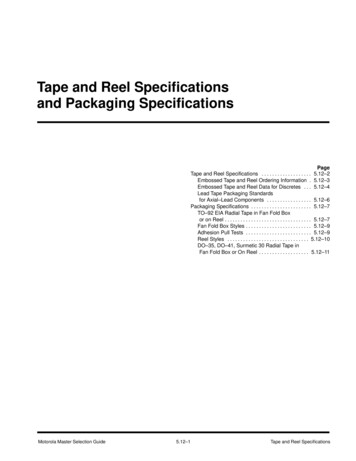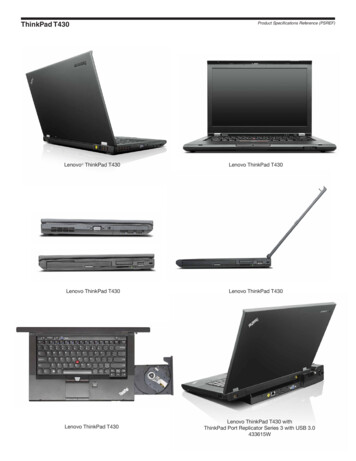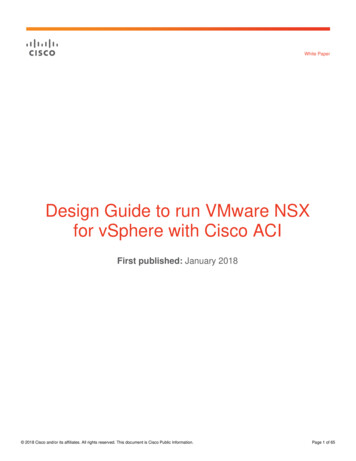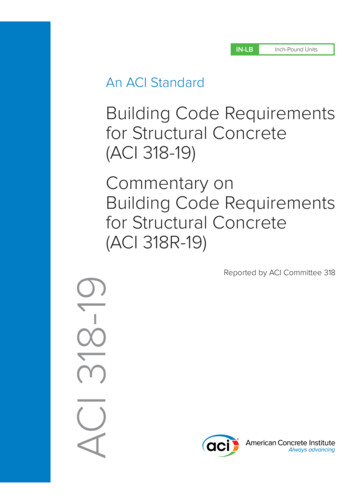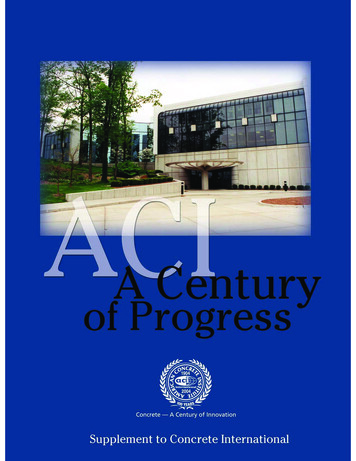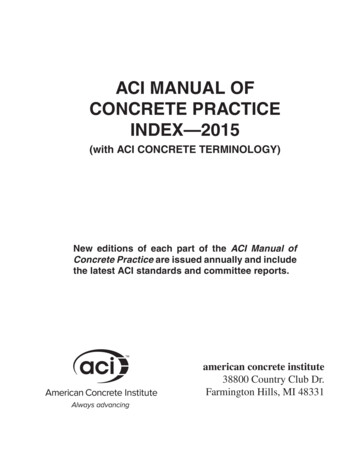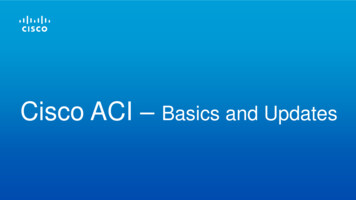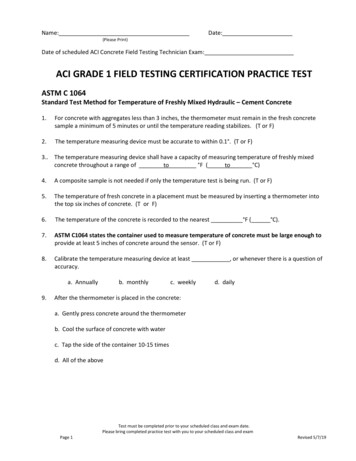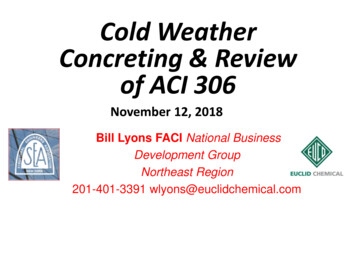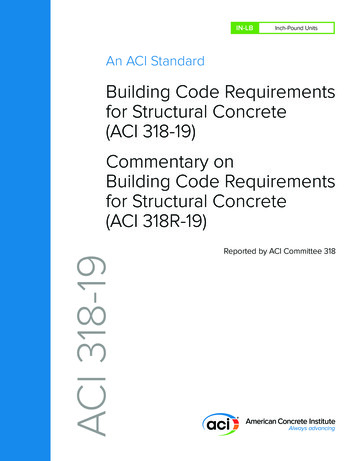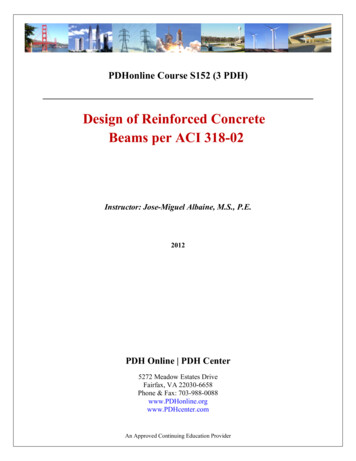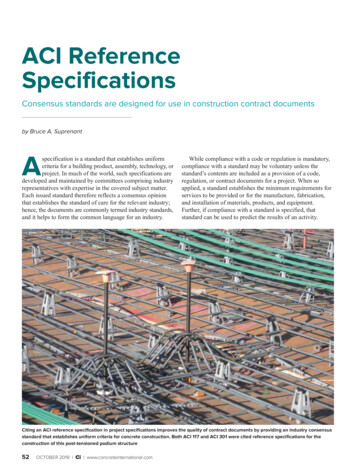
Transcription
ACI ReferenceSpecificationsConsensus standards are designed for use in construction contract documentsby Bruce A. SuprenantAspecification is a standard that establishes uniformcriteria for a building product, assembly, technology, orproject. In much of the world, such specifications aredeveloped and maintained by committees comprising industryrepresentatives with expertise in the covered subject matter.Each issued standard therefore reflects a consensus opinionthat establishes the standard of care for the relevant industry;hence, the documents are commonly termed industry standards,and it helps to form the common language for an industry.While compliance with a code or regulation is mandatory,compliance with a standard may be voluntary unless thestandard’s contents are included as a provision of a code,regulation, or contract documents for a project. When soapplied, a standard establishes the minimum requirements forservices to be provided or for the manufacture, fabrication,and installation of materials, products, and equipment.Further, if compliance with a standard is specified, thatstandard can be used to predict the results of an activity.Citing an ACI reference specification in project specifications improves the quality of contract documents by providing an industry consensusstandard that establishes uniform criteria for concrete construction. Both ACI 117 and ACI 301 were cited reference specifications for theconstruction of this post-tensioned podium structure52OCTOBER 2019 Ci www.concreteinternational.com
Reference specifications can thus be important resourcesfor code officials and specifiers creating contract documents.This article provides guidance in the use of such standardswith particular focus on ACI’s vast collection of constructionstandards.Why Use Reference SpecificationsThe Construction Specification Institute (CSI) lists manyadvantages for the use of reference specifications, including:Quality assurance—The organizations that developspecifications are experts in their respective fields ofinterest, and their specifications are the product ofextensive research, experience, and lessons learned;Uniformity—Specifications represent the consensus of anational network within a field of interest;Reduced conflict and duplication—The AmericanNational Standards Institute (ANSI) coordinates standardsdevelopment and adopts and promotes the standardsdeveloped by its accredited members to ensure reliability; andReduced work—Incorporation of standards into contractdocuments by reference saves the time required for writingan elaborate and lengthy text. Of course, any referencestandard should be reviewed, and its content and purposemust be understood before including it in the specifications.However, there can also be risk in using referencestandards. CSI cautions that the specifier should specify onlythose standards that are most appropriate for the product andapplication. The specifier must carefully consider the level ofquality defined by the reference standard, as some standardsmay define quality in terms of minimum requirements that areso restrictive that they exclude most commercially availablematerials. Alternatively, other standards may be so liberal thatnearly anything produced can meet them.Specifiers should maintain a current library of referencestandards, and they must understand how the standards applyto the products they intend for each project. Each referencespecification must be reviewed as part of the full projectspecification, not only to ensure that the owner’s requirementsare being met but also to avoid the creation of duplicate orconflicting product requirements. The specifier also mustunderstand the effects of references within the referencestandards, as these can also result in conflicting requirements.Lastly, the specifier must address optional provisions withinreference specifications, with the goal of producing coherentand complete instructions. Citing and Using Reference SpecificationsThe entirety of a reference specification can beincorporated into contract documents for a project by referringto the name of the association that developed the specificationand including number, title, or other designation of thespecification (Fig. 1). The specification then becomes areference specification, and it becomes a part of the projectspecifications. Incorporation of an ACI specification byreference takes advantage of an established body ofSECTION 03 30 00 Page xPART 1 GENERAL1.1 REFERENCESThe publications listed below form a part of thisspecification. The publications are referred to within thetext by the basic designation only.AMERICAN CONCRETE INSTITUTE (ACI)117-10(15), Specifications for Tolerances for ConcreteConstruction and Materials, 2015301-16, Specifications for Structural Concrete, 2016Fig. 1: An excerpt from a project specification. The ACI documentsare reference specifications that are listed in Division 03 00 00 in theAIA MasterSpec and are commonly used in project specificationsknowledge developed by the concrete industry, and it savesthe architect and/or the engineer the work (and alleviatesmuch of the risk) of writing an elaborate and lengthyspecification.ACI SpecificationsACI specifications undergo standardization, whichprovides the widest input and highest overall qualityassurance for a document. This is the most rigorous consensusprocess used by ACI, and it is approved by ANSI. ACIstandards are written in mandatory language and can bereferenced by model codes, by authorities having jurisdictionover local building codes, persons or agencies that providespecifications, or in legal documents such as projectspecifications and manuals.ACI specifications are developed in a seven-step processcomprising:Preparation of a new document or revision of an existingdocument;Letter balloting of the draft document by the committee;Submission of the committee-approved document forreview by ACI’s Technical Activities Committee (TAC);Revision of the document in response to comments fromTAC;A 45-day public discussion period in which members of thedesign, construction, owner, and general public are invitedto submit comments regarding the document;Submission of committee-approved responses to commentsreceived during the public discussion period for TACreview; andSubmission to ACI Standards Board for final approval.ACI specifications must be worded in explicit, mandatorylanguage designed to avoid misinterpretation. Specificationsmust also cite only mandatory-language documents.References to nonmandatory-language documents such asguides, reports, papers, and research results can be made inthe document’s notes to the specifier, which is a form ofcommentary.ACI construction standards include the followingdocument types that can be incorporated by reference within www.concreteinternational.com Ci OCTOBER 201953
contracts, either between an owner and a contractor, betweenan owner and a producer, or between an owner and a testingor inspection agency:Construction specifications—Documents that providerequirements for the products and finishes to be used in aproject are instructions written to the contractor, and maybe incorporated by reference into contracts between anowner and a contractor (typically called contract documents);Material specifications—Documents that prescriberequirements for materials used in projects are instructionswritten to the producer, and may be incorporated byreference into construction specifications or into contractdocuments;Test methods—Documents that prescribe means of testingfor compliance (acceptance testing) of materials orconstruction methods to be used in projects are written asinstructions to the testing agency, and may be incorporatedby reference in material specifications, constructionspecifications, or contract documents;Inspection services specifications—Documents thatprescribe the test methods and scope to be used for qualityassurance testing are written as instructions to theinspection agency, and may be incorporated by reference ina contract between an owner and an inspection agency; andTesting services specifications—Documents written asinstructions to the testing agency as part of a contractbetween an owner and a testing agency or between acontractor and a testing agency. What’s Inside an ACI Reference SpecificationCurrent ACI reference specifications are listed in Table 1.These documents are written in the three-part section formatTable 1:A listing of ACI reference specifications as of September 2019Construction specificationsACI 117-10(15)Specification for Tolerances for Concrete Construction and Materials and CommentaryACI 301-16Specifications for Structural ConcreteACI 305.1-14Specification for Hot Weather ConcretingACI 306.1-90Standard Specification for Cold Weather ConcretingACI 308.1-11Specification for Curing ConcreteACI 330.1-14Specification for Unreinforced Concrete Parking Lots and Site PavingACI 336.1-01Specification for the Construction of Drilled PiersACI 440.5-08Specification for Construction with Fiber-Reinforced Polymer Reinforcing BarsACI 503.3-10Specification for Producing a Skid-Resistant Surface on Concrete by the Use of Epoxy and AggregateACI 503.4-92Standard Specification for Repairing Concrete with Epoxy MortarsACI 503.7-07Specification for Crack Repair by Epoxy InjectionACI 506.2-13(18)Specification for ShotcreteACI 522.1-13Specification for Pervious Concrete PavementACI 548.4-11Specification for Latex-Modified Concrete OverlaysACI 548.8-19Specification for Type EM (Epoxy Multi-Layer) Polymer Overlay for Bridge and Parking Garage DecksACI 548.9-08Specification for Type ES (Epoxy Slurry) Polymer Overlay for Bridge and Parking Garage DecksACI 548.10-10Specification for Type MMS (Methyl Methacrylate Slurry) Polymer Overlays for Bridge and Parking Garage DecksACI 548.12-12Specification for Bonding Hardened Concrete and Steel to Hardened Concrete with an Epoxy AdhesiveACI 548.13-14Specification for Bonding Fresh Concrete to Hardened Concrete with a Multi-Component Epoxy AdhesiveACI 548.14-14Specification for Repairing Concrete with Epoxy MortarITG-07-09Specification for Tolerances for Precast ConcreteTesting services specificationsACI 311.6-18Specification for Testing Ready Mixed ConcreteACI 350.1-10Specification for Tightness Testing of Environmental Engineering Concrete Containment Structures and CommentaryInspection services specificationsACI 311.7-18Specification for Inspection of Concrete ConstructionACI 350.5-12Specification for Environmental Concrete StructuresMaterials specifications54ACI 423.7-14Specification for Unbonded Single-Strand Tendon MaterialsACI 440.6-08(17)Specification for Carbon and Glass Fiber-Reinforced Polymer Bar Materials for Concrete ReinforcementACI 440.8-13Specification for Carbon and Glass Fiber-Reinforced Polymer (FRP) Materials Made by Wet Layup for ExternalStrengthening of Concrete and Masonry StructuresOCTOBER 2019 Ci www.concreteinternational.com
of CSI as modified by ACI:Part 1 covers general administrativerequirements such as definitions,submittals, referenced standards, andacceptance criteria;Part 2 addresses products andmaterials; andPart 3 deals with execution.ACI single-item specificationsaddress a single product or process, andthey are like the CSI narrow-scopespecifications. ACI multiple-itemspecifications address more than onetechnical product or process, and theyare like CSI’s broad-scopespecifications.ACI construction specifications arewritten to the contractor and must bereferenced in contract documents. ACIspecifications do not includecommentaries. The specification isfollowed by notes to specifiers andchecklists, which are directed to thespecifier and are not part of thespecification.Notes to Specifier—Includes a listof cited references, a mandatoryrequirements checklist, and an optionalrequirements checklist. The generalnotes provide guidance on how toincorporate the ACI specification intocontract documents. The foreword to thechecklists explains how to modify theACI specification in contract documentsfor the project.The mandatory requirementschecklist identifies provisions that donot have a default requirement andspecific requirements must be providedin contract documents. The optionalrequirements checklist identifiesalternatives to default requirements oroptional requirements that the specifiermay want to incorporate throughcontract documents. Checklists do notprovide explanations for therequirements; instead, refer to ACIguides and reports for additionalinformation.Mandatory RequirementsChecklist—Identifies information thatis required to be included in contractdocuments because there is no defaultrequirement in the specification. Adefault requirement is a limiting requirement that has been selected forthe specification. Unless otherwisespecified in contract documents, defaultrequirements are mandatory conditionsof the specification. Table 2 shows themandatory requirements checklist forthe first five Sections of ACI 301-16.Because ACI 301 does not provide adefault value for the items listed, thespecifier must include a requirement inthe project specifications; otherwise,there is no contractor requirement.Optional RequirementsChecklist—Describes items that thespecifier may wish to include in thecontract documents. These items canACI Multi-User/Multi-Site SolutionsFrom a single title, to a custom selection, to ACI’s fullcollection, the American Concrete Institute partners withleading distributors to provide access to the Institute’spublished content for multiple locations and/or multiple users.CUSTOMIZABLE COLLECTIONMULTIPLE USERS MULTIPLE LOCATIONSBUNDLE WITH OTHER l.com Ci OCTOBER 201955
Table 2:Mandatory requirements checklist for the first five sections of ACI 301-16MANDATORY REQUIREMENTS CHECKLISTSection/Part/ArticleNotes to SpecifierFormwork and formwork accessories2.2.1.5Specify mate
ACI 301-16 Specifications for Structural Concrete ACI 305.1-14 Specification for Hot Weather Concreting ACI 306.1-90 Standard Specification for Cold Weather Concreting ACI 308.1-11 Specification for Curing Concrete ACI 330.1-14 Specification for Unreinforced Concrete Parking Lots and Site Paving ACI 336.1-01 Specification for the Construction of Drilled Piers ACI 440.5-08 Specification for .
